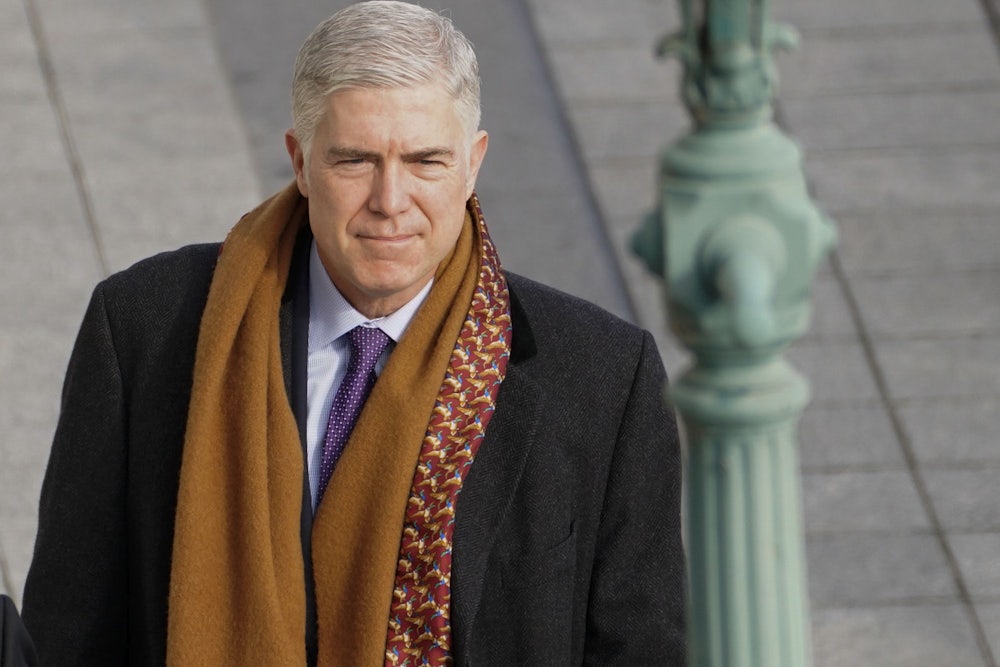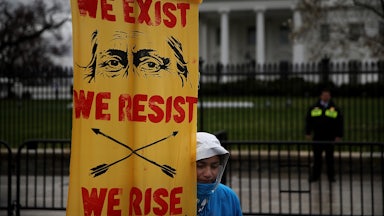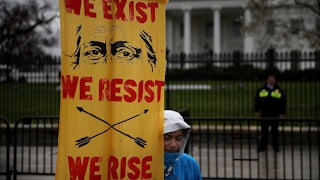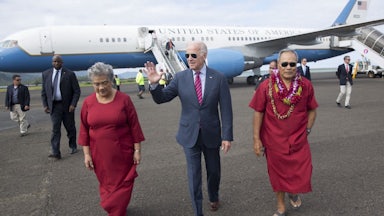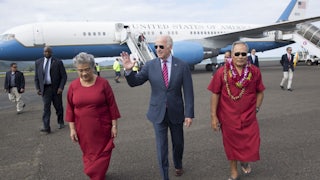The Indian Child Welfare Act, or ICWA, is one of the most vital tools that Native people have at their disposal to guard against cultural genocide. Enacted in 1978, ICWA was a response to a long-running crisis among Native people: Native children, in large numbers, were being separated from their families and communities by state and private adoption agencies and being disproportionately placed with families at a substantial remove from Native culture and tradition. The federal law imposed safeguards on state courts to help place Native children with Native families and prevent further damage.
Those successes are now in danger from a legal campaign that hopes to demolish the ICWA—and much more. As my former colleague Nick Martin explained in August 2019, ICWA has increasingly been beset by right-wing challenges to the law’s primacy. The organizations that have mounted these attacks argue that the law hurts Native children by “limiting their field of potential foster homes and adoptive parents.” But this rationale is cover for their true design: decimating the legal regime that allows for tribal sovereignty. “If ICWA were overturned,” Martin writes, “it could open a window to challenge numerous other laws and regulations; a Native nation’s (admittedly already limited) ability to safeguard natural resources on its lands or a tribe’s right to determine who is a citizen could be next on the hit list.”
The law’s fate—and the power of Native people to protect their cultures—will be in the hands of the Supreme Court if it decides to take up the consolidated case Haaland v. Brackeen this term. The case revolves around the Brackeens, a white evangelical couple in Texas who wanted to adopt a Cherokee and Navajo boy they had fostered. The Navajo Nation intervened in the adoption case and identified a Navajo family that would take him in instead. Under the ICWA, state courts generally must place children who are tribal members or eligible to become tribal members with family members, members of the same tribe, or members of another tribe whenever possible. The Brackeens filed the lawsuit in question here and eventually prevailed in the adoption after the Navajo Nation withdrew from that case; they are currently seeking to adopt the boy’s half-sister, as well.
The Brackeens’ lawsuit is joined by the states of Texas, Indiana, and Louisiana, as well as a few other families in similar situations. It is also backed by the Goldwater Institute, a right-wing think tank with a libertarian bent, favoring property rights and privatized schools while opposing government regulations. The Goldwater Institute has argued in its legal campaigns against the ICWA that its treatment of Indian children amounts to racial discrimination in violation of the Fourteenth Amendment’s Equal Protection Clause. The Brackeens and their allies made largely identical arguments in litigation, in addition to arguing that Congress had violated principles of federalism by regulating state adoption proceedings through the ICWA.
“Each year, tens of thousands of American Indian children are adopted,” the Brackeens told the court in their petition. “The issues presented in this petition are critical to each of these children and the parents—both biological and adoptive—that are trying to provide a nurturing home for them. As [we] know all too well, ICWA’s constitutionality can be the difference between adopting a child they love or seeing that child wrenched away from them.”
The problem for the Brackeens’ claims of racial discrimination is that almost all of federal Indian law runs counter to it. In the 1974 case Morton v. Mancari, the Supreme Court unanimously upheld long-standing hiring preferences in the federal Bureau of Indian Affairs that favored qualified tribal members. The justices rejected the premise that the preference amounted to racial discrimination. Instead, they noted, it flowed logically from the unique political relationship between the federal government and the tribes. “As long as the special treatment can be tied rationally to the fulfillment of Congress’ unique obligation toward the Indians, such legislative judgments will not be disturbed,” Justice Harry Blackmun wrote for the court.
The federal government, joined by multiple tribes, urged the lower courts to reject the Brackeens’ lawsuit on multiple grounds. They argued that the ICWA was necessary to protect Indian children from being taken away from their tribes and cultures, a danger carried out in past generations through boarding schools and forced assimilation that devastated tribal communities. “For four decades, these standards have dramatically reduced unwarranted removals,” a coalition of tribes told the justices in their petition. “While work remains to be done, ICWA has become the ‘gold standard’ for child-welfare practices generally—not just for Indians.”
Unfortunately for the tribes, however, their lawsuit was assigned to Judge Reed O’Connor, a George W. Bush appointee to the federal district court in northern Texas. O’Connor is famous (or perhaps infamous) for handing down favorable rulings to right-wing plaintiffs on highly questionable legal and constitutional grounds. In perhaps the highest-profile example, he concluded in a widely criticized ruling that the entire Affordable Care Act had become unconstitutional after Congress zeroed out the individual-mandate penalty a few years ago. The Supreme Court reversed O’Connor in a 7–2 majority that included four members of the court’s conservative bloc.
True to form, O’Connor ruled in 2018 that the entire Indian Child Welfare Act was unconstitutional on multiple grounds, including the Tenth and Fourteenth Amendments. Perhaps most importantly, he concluded that the ICWA amounted to racial discrimination. The relationship between race, tribal membership, and Native identity is complex and nuanced, as Martin noted last year. Not all people of Native descent are eligible for membership in a federally recognized tribe, and not all members of federally recognized tribes are genetically descended from pre-Columbian Indigenous peoples. The Cherokee Nation, for example, granted membership in an 1866 treaty to many of the people it had previously enslaved.
Since Mancari, the courts have generally recognized that tribal membership is a political classification instead of a racial one. The ICWA is built around the idea that the “Indian child” to which it applies is either a member of a tribe or would otherwise be eligible for membership themselves through a parent. O’Connor got around this by reading Mancari as narrowly as he possibly could. “Mancari therefore did not announce that all arguably racial preferences involving Indians are actually political preferences,” he wrote. “Instead, the Supreme Court recognized that applying its decision more broadly would raise the ‘obviously more difficult question that would be presented by a blanket exemption for Indians.’”
His interpretation is less than persuasive. It relies heavily upon Rice v. Cayetano, a 2000 case where the court only concluded that Mancari did not extend to allowing Hawaii to exclude non-Indigenous voters from statewide elections for certain offices. (Though Native Hawaiians do not fall under the framework of federally recognized tribes, the court said the ruling would be no different if they were.) O’Connor also adopted a strained reading of Mancari itself. In the 1974 ruling, the justices were careful to distinguish between preferences for Native Americans in general and more targeted measures connected to tribal membership. O’Connor’s quotation of the ruling on a “blanket exemption for Indians,” which he cited multiple times, is tellingly incomplete. It can be found near the end of the court’s opinion, which I’ll quote (emphasis mine) at greater length:
The [hiring] preference, as applied, is granted to Indians not as a discrete racial group, but, rather, as members of quasi-sovereign tribal entities whose lives and activities are governed by the [Bureau of Indian Affairs] in a unique fashion. In the sense that there is no other group of people favored in this manner, the legal status of the BIA is truly sui generis. Furthermore, the preference applies only to employment in the Indian service. The preference does not cover any other Government agency or activity, and we need not consider the obviously more difficult question that would be presented by a blanket exemption for Indians from all civil service examinations. Here, the preference is reasonably and directly related to a legitimate, nonracially based goal. This is the principal characteristic that generally is absent from proscribed forms of racial discrimination.
When O’Connor referred to only a “blanket exception for Indians” in his opinion, he presented it as if the court meant a “blanket exemption” from the Fourteenth Amendment’s general ban on racial discrimination. The court in Mancari, however, was discussing a hypothetical “blanket exception” from all federal civil service exams at the time. Given the surrounding context, it’s more reasonable to conclude that the court thought such an exemption would be an “obviously more difficult question” because it would be detached from a “legitimate, nonracially based goal,” as well as from Congress’s unique relationship with tribal governments. That question is far less difficult when it comes to the ICWA.
This might sound like a hypertechnical parsing of words, but the distinction has immense practical consequences for Indian country—consequences that the court itself recognized when it handed down Mancari. “Literally every piece of legislation dealing with Indian tribes and reservations, and certainly all legislation dealing with the BIA, single[s] out for special treatment a constituency of tribal Indians living on or near reservations,” Blackmun wrote for the court. “If these laws, derived from historical relationships and explicitly designed to help only Indians, were deemed invidious racial discrimination, an entire Title of the United States Code (25 U.S.C.) would be effectively erased and the solemn commitment of the government toward the Indians would be jeopardized.”
The federal government and the tribes quickly appealed O’Connor’s ruling to the Fifth Circuit Court of Appeals. In April, the court handed down an extraordinarily fractured 325-page ruling, in which none of the judges’ individual opinions commanded a majority. Even a brief summary of the ruling is hard to provide; the court’s own synthesis of its conclusions is five pages long. In the broadest strokes, the court upheld the ICWA as a valid exercise of Congress’s legislative power. It also generally rejected O’Connor’s conclusion that the ICWA’s definition of “Indian child” was a racial preference but deadlocked on applying that reasoning to some parts of the ICWA’s placement-preference framework.
The court rejected O’Connor’s conclusions that the ICWA violated the nondelegation doctrine, as well as an administrative law claim he had favored. When it came to the Tenth Amendment claims, however, the Fifth Circuit left most of O’Connor’s ruling intact. For some provisions of the ICWA, the court agreed that Congress had unconstitutionally “commandeered” state adoption proceedings. For other provisions, it split evenly on the question, leaving O’Connor’s ruling intact but setting no precedent in future cases. The Fifth Circuit’s ruling was so muddled that, earlier this month, four different litigants—the federal government, the Cherokee Nation and three other tribes, the state of Texas, and the Brackeens—asked the Supreme Court to review it.
Interior Secretary Deb Haaland, who happens to be the first Native American Cabinet secretary, urged the court to overturn the Fifth Circuit’s anti-commandeering rulings and break the deadlock on whether some parts of the preference-placement system were racially discriminatory. “Although ICWA has helped stem the widespread removal of Indian children from their families and tribes since its enactment 40 years ago, Indian children are still disproportionately more likely to be removed from their homes and communities than other children today,” Haaland told the court, citing federal findings on the matter. “ICWA’s provisions thus remain essential and are frequently applied in state courts across the country.” Both the government and the tribes also disputed that the litigants had standing to bring the case at all.
Texas and the Brackeens essentially urged the justices to strike down the parts of the ICWA that O’Connor and the Fifth Circuit did not. They frequently refer to arguments made in concurring and dissenting opinions by Justice Clarence Thomas, who questioned both the ICWA’s constitutionality and Congress’s plenary power over the tribes in a 2012 case, to suggest that the court has “not clearly defined” where Congress’s power flows from in these matters. Thomas’s concurring and dissenting opinions do not carry precedential weight, but Texas and the Brackeens are nonetheless trying to transmute them into constitutional law.
In one particularly cynical footnote, the Brackeens argued that even if the court adopts their race-based approach to Indian law, the other federal statutes that would be affected are largely nineteenth-century relics of a more overtly racist past, including one that contributed to the problem the ICWA was designed to fix. “To be sure, some courts have worried that applying equal-protection principles in this context may undermine a few nineteenth-century federal laws that are still on the books, such as the ‘[l]imitation of rights of white men marrying Indian women,’ or the provision forcibly ‘[p]lacing Indian pupils in Indian Reform School,’” the Brackeens wrote, citing a 1965 ruling from a federal court in Washington.
Native leaders and commentators disagree. “Indigenous nations that have existed since the beginning of time have watched the ground underneath them change with one court decision, or the whims of one administration,” Rebecca Nagle, host of the This Land podcast, said in an episode on the case. “That’s why the Brackeen’s case is scary. If the Supreme Court decides that the Brackeens … or the foster children were discriminated against based on race, it could set off a chain reaction, one that could impact the constitutionality of tribal land, police, health services, gaming, even tribal governments. Sure, we could still have pow-wows and museums, but we would no longer be able to govern ourselves.”
The ICWA ensured that tribes could maintain their cultural and linguistic traditions after decades of conscious efforts by the federal government to destroy them. “In 1978, Indian children, families, and tribes faced a crisis,” the tribes noted in their petition, citing historical sources. “An ‘alarmingly high percentage of Indian families’ were ‘broken up by the removal, often unwarranted, of their children,’ with an ‘alarmingly high percentage … placed in non-Indian’ homes. More than a quarter of Indian children found themselves sundered from family and Tribe, often due to the ignorance and contempt of case workers who believed Indian children were better off raised by non-Indian families. Survival itself—for families, and for tribes—was at stake.”
There is no foolproof way to predict whether the Supreme Court will take up a specific case among the thousands of requests it receives each year. But Haaland v. Brackeen falls within some of the circumstances where it is most likely to intervene. It involves an act of Congress that was invalidated by a lower court, where the Fifth Circuit could only cobble together a deeply fractured ruling on some aspects and deadlocked on others and introduced greater uncertainty into federal and state court procedures. How the justices would handle the case is far less clear. Their 7–2 decision in California v. Texas shows that they are more than willing to overturn O’Connor’s off-base rulings when given the chance. The federal government and the tribes challenged the standing of the Brackeens and the other families in the lower courts, possibly giving the justices an off-ramp to unwind the entire case if they want it.
How they would approach the merits is also uncertain. Though Thomas has signaled that he would be willing to revisit the basics of federal Indian law, the other justices have not. Justice Neil Gorsuch, the only Westerner on the court, is also one of its clearest voices when it comes to holding the federal government accountable for promises made to tribes. It would be hard to square his ruling in McGirt v. Oklahoma two years ago, for example, with such a radical effort to undermine tribal sovereignty. But other aspects of the case, particularly whether Congress violated the Tenth Amendment by “commandeering” state adoption cases or violated the nondelegation doctrine by giving tribes a say in them, may be more appealing to the court’s conservative justices.
This isn’t the only high-stakes case on Indian country that could be taken up by the justices this term. Last month, the state of Oklahoma and its corporate allies urged the court to overturn McGirt entirely, claiming the decision to recognize most of eastern Oklahoma as a reservation had upended the state’s criminal justice system. (The tribes strenuously disagree.) The two cases involve wildly disparate factual circumstances and entirely different legal disputes. But they both spring from the same fundamental question: whether the federal government in general—and the Supreme Court in particular—will treat Indian country with the sovereignty and respect it has long sought and was long denied.
